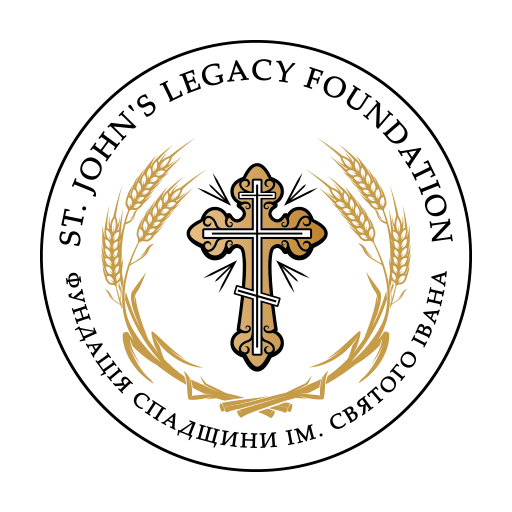Sts. Peter and Paul Ukrainian Orthodox Church – Thorhild (UOC)
The origins of congregational activity in the Thorhild area can be traced as far back as 1931 to missionary activity in the Tudor district. However, as was increasingly the case in much of rural Alberta, the focus of church activity gradually shifted over time from the countryside to the nearest town. This was Thorhild, the county seat and the leading commercial centre in the region.
Eventually, a meeting involving sixteen representatives of local families was held at the home of Anna and Evsey Kovalenko on 18 March 1945 to discuss establishing a full-fledged congregation. Until that time, the Ukrainian Orthodox faithful in the Thorhild community would worship at St. John’s Ukrainian Orthodox Church near Egremont, or occasionally hosted services in family homes, the Tudor Narodnyi Dim north of Thorhild, or in the Thorhild School.
Early pastoral care was provided by Reverends T. Horbay and E. Olendy. They would arrive in Thorhild by train and would then be transported to the place of worship by horse and buggy, sleigh, or a Model T. Ford. In this way, the seeds were sown for the initiation of congregational life in Thorhild.
Although the Ukrainian Orthodox residents of the Tudor district had previously obtained land for a cemetery and constructed a Narodnyi Dim, they decided to forgo building a church in the countryside. Instead, they joined forces with the inhabitants of Thorhild to erect a sanctuary in the village.
In April 1945, a lot was bought in the village for a church from Evsey Kovalenko for $338. Construction began in 1947. Work was completed and the church was formally blessed on 22 August of the following year. Blessing occurred during a memorable visit by Archbishop Mstyslaw Skrypnyk—who in 1991 became the first Patriarch of Kyiv.
To raise money for the project, a wide variety of fundraising events were held to supplement individual donations, including dances, bazaars, box socials, winter carnivals, masquerades and whist drives. Besides catering banquets and weddings, the members of the church also raised money by Christmas carolling.
In 1963 the church basement was developed to create a facility suitable for holding dinners, meetings, and cultural events. The following year, the sanctuary itself was refurbished. The investment in the church basement proved to be auspicious. In the 1966-1967 school year it was used to conduct an elementary class due to overcrowding in Thorhild schools. Church school and Ukrainian school classes were also held in the church basement, In 1976 Thorhild congregation held its first Harvest Ball that subsequently became a very popular annual social event in the community.
Sadly, Sts. Peter and Paul church burnt down in an electrical fire on 28 February 2015. It was being cleaned for Sunday service the following day. Although six members of the congregation were inside when the fire started, it was impossible save anything from the interior, including the iconostas by Vera Senchuk, or any chalices, banners, or interior furnishings. At the time of the sanctuary’s destruction, the congregation had 24 members.
(In 2016, the church was rebuilt on its original location in Thorhild. The photographs in the Photo Gallery were taken of the new church in 2024).
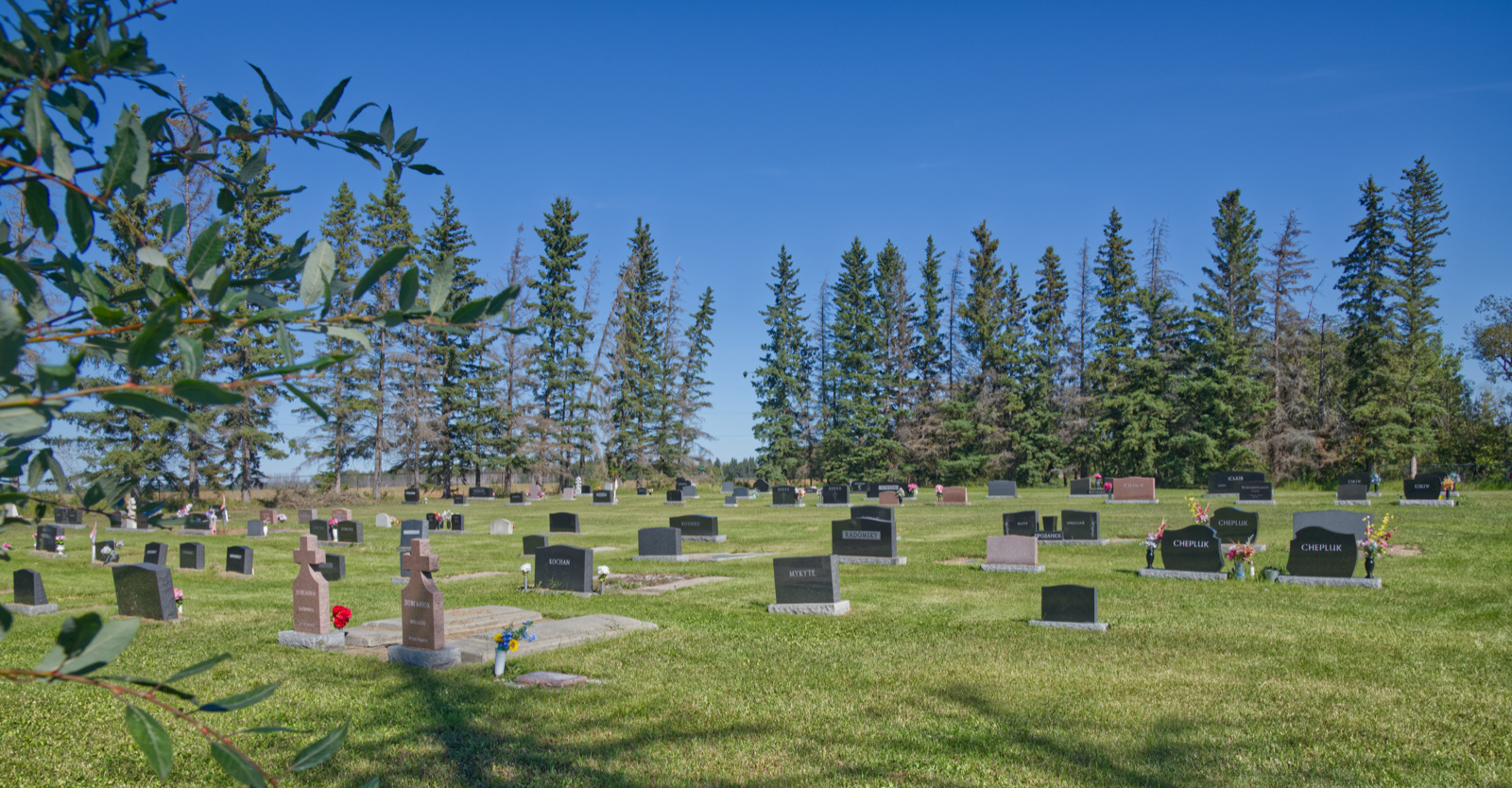
Play Memory Eternal Chant
Visit this Cemetery
GPS Co-ordinates: 54.160934, -113.125147
Cemetery GPS: 54.15877, -113.13566
Affiliation: Ukrainian Orthodox Church of Canada
Sts. Peter and Paul Ukrainian Orthodox Church – Thorhild, AB
St. Volodymyr Ukrainian Orthodox Church – Westlock (UOC)
The Westlock area in Alberta, inhabited by non-Ukrainians for over 40 years, saw the arrival of Ukrainian settlers in the 1930s. Initially, there was no Orthodox church in the area, so residents attended services in Edmonton. As the number of Orthodox Ukrainians grew, they established a parish in 1956. The first Divine Liturgy was held on February 26, 1956, in an Anglican church by Fr. E. Hrytsyna, then-administrator of the Western Eparchy. The second service took place on March 11, 1956, followed by the founding assembly, which elected the first parish council: Chairman: Yu. Seniuk, Vice-Chairman: D. Luchka, Secretary: M. Kostiv, Treasurer: S. Mahas, Audit Committee: S. Melnyk, I. Hrushka, and Mrs. Anna Kostiv, Senior Brother: O. Hobliak, Sisterhood Leader: Mrs. Maria Yaremko,
Three years later, Fr. Blazhuk became the first resident priest and helped organize the Women’s Society of St. Olga.
In 1956, the decision was made to build a church. On May 3, 1957, construction began, and the first service in the new church was held on the Feast of St. Volodymyr, Sunday, July 28, 1957, coinciding with the 39th anniversary of the revived Ukrainian Greek Orthodox Church in Canada.
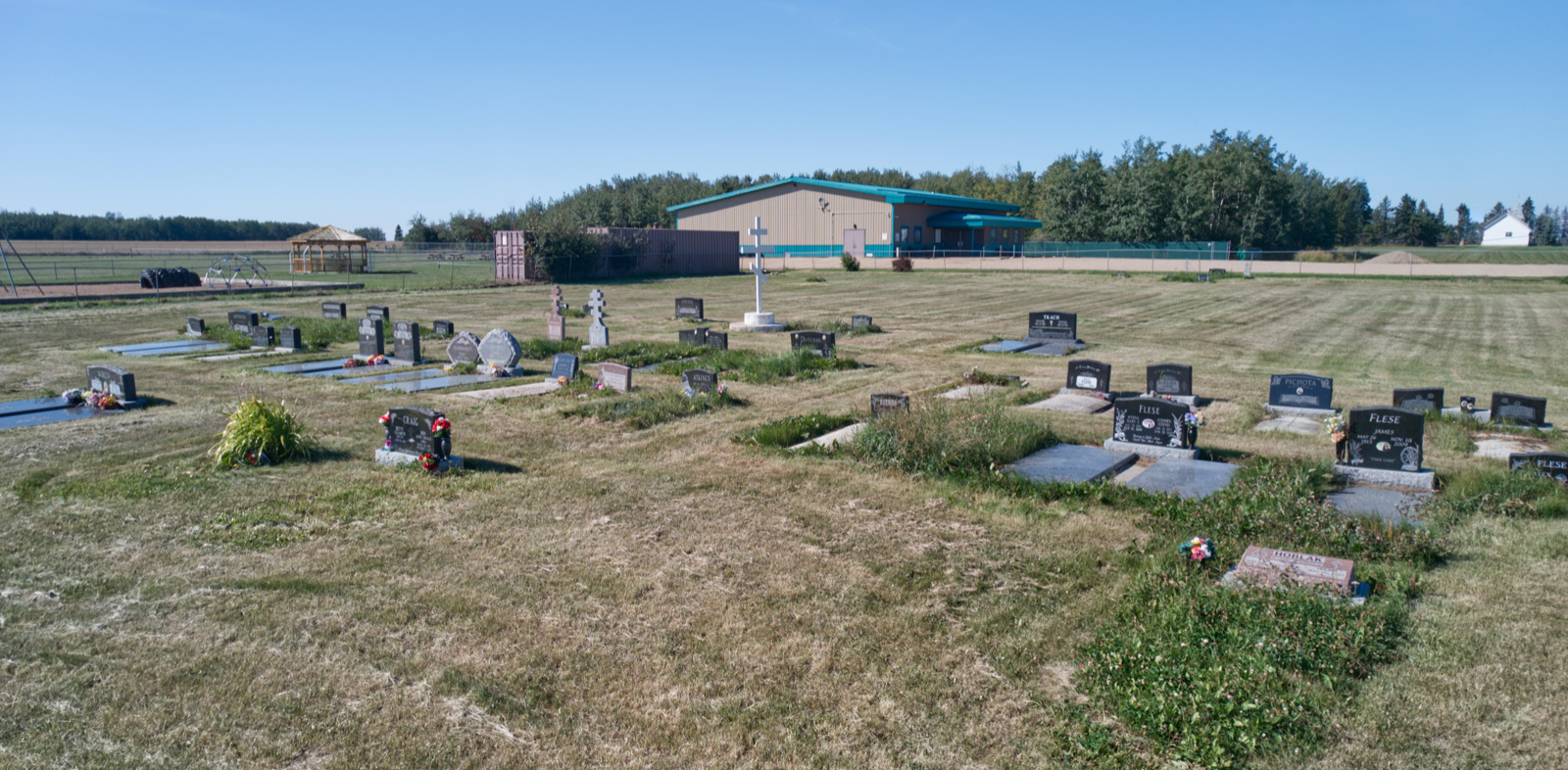
Play Memory Eternal Chant
Visit this Cemetery
GPS Co-ordinates: 54.152538, -113.840362
Cemetery GPS: 54.15168, -113.99616
Affiliation: Ukrainian Orthodox Church of Canada
St. Volodymyr Ukrainian Orthodox Church – Westlock, AB
Dormition of St. Mary Ukrainian Orthodox Church – Newbrook (UOC)
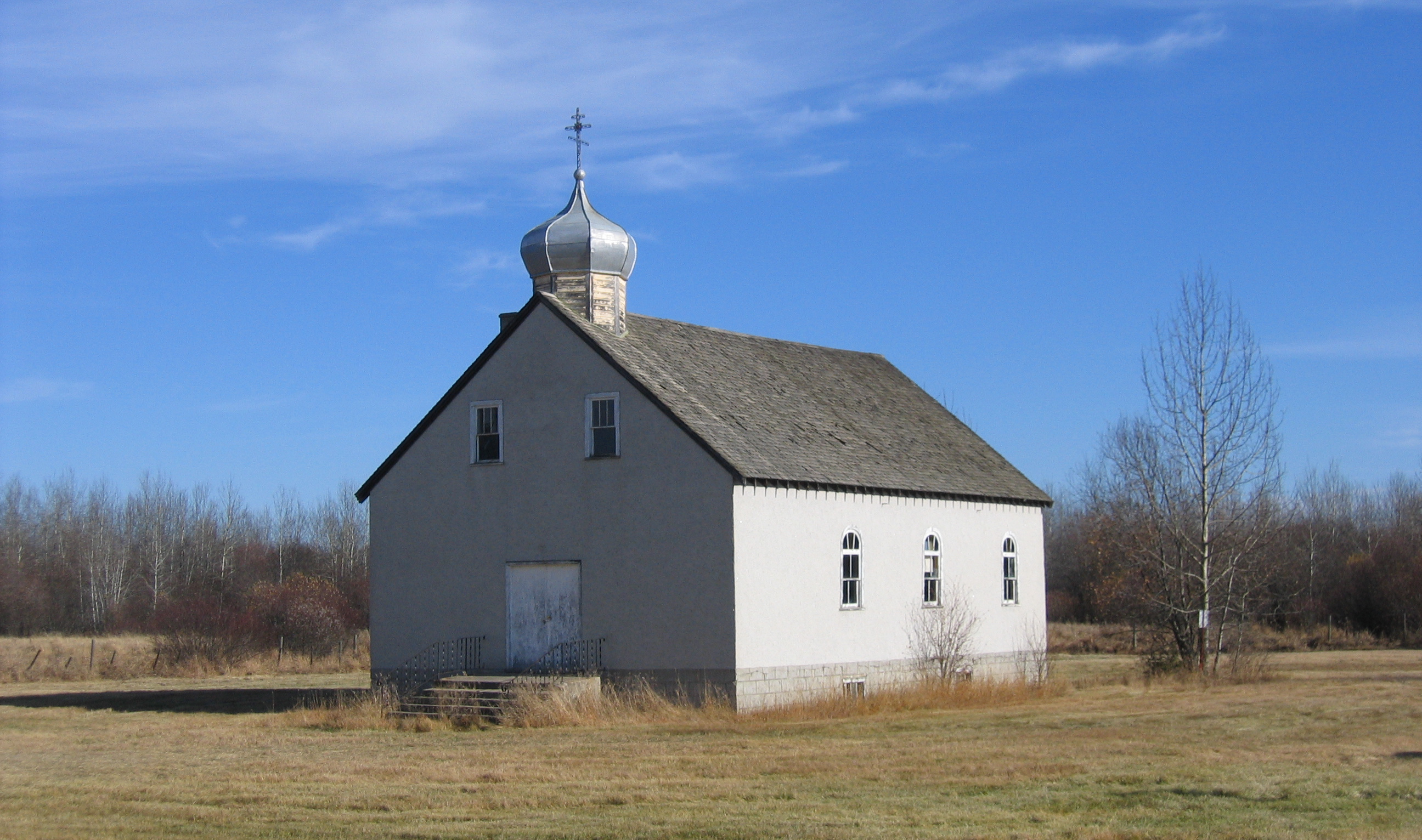
Photographs | Churches
Initiated on 29 June 1952, the congregation originally adopted the name Holy Ghost Ukrainian Orthodox Church. However, when a formal application for membership in the Ukrainian Greek Orthodox Church of Canada was submitted after a meeting held on 28 February 1954, the name of the new parish was changed to that of the Dormition of the Virgin Mary. With the establishment of this parish, a congregation that had been active in the nearby community of Danube dissolved itself. Instead, they joined forces with their fellow Orthodox adherents in Newbrook. Indeed, the organization of the latter merely marked the continuation of the existence of the former in a new location.
Construction of a sanctuary began in 1956, when congregation consisted of ten families, but only three registered members. That same year eight services were held in the community by the priest resident in Radway.
Play Memory Eternal Chant
Visit this Cemetery
GPS Co-ordinates: 54.152538, -113.840362
Cemetery GPS: 54.15168, -113.99616
Affiliation: Ukrainian Orthodox Church of Canada
St. Mary Ukrainian Orthodox Church – Newbrook, AB
All Saints Ukrainian Orthodox Church – Lac La Biche (UOC)
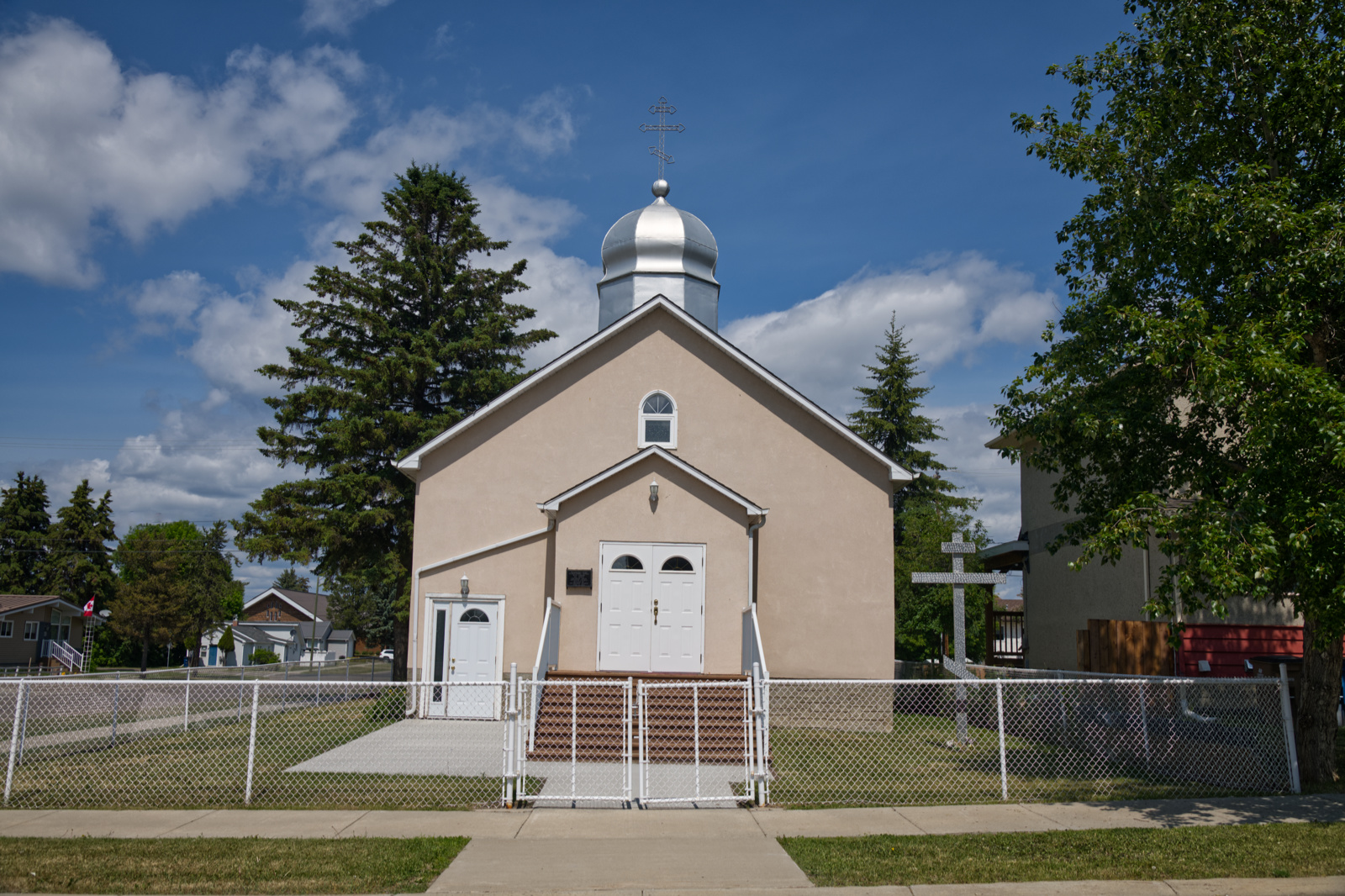
T
The Lac La Biche area was originally visited by Ukrainian Orthodox priests in the early 1930s, among them Fr. Semen Sawchuk in August of 1939. A few services were also held in Lac La Biche itself during the 1940s at the local Anglican Church. It was rented for the sum of $8 to host a Divine Liturgy celebrated by Fr. H. Wasyliw on 2 September 1951. It was then that the idea of building a church in town probably first took root.
A major role in mobilizing the Lac La Biche Orthodox community was played by the establishment of a branch of the Ukrainian Women’s Association on the initiative of Alice Gordichuk (who was originally from Willingdon) on 13 October 1951. On 2 March of the following year, the loosely constituted congregation elected a founding executive comprised of William Gordichuk, Fred Warawa, and Eli Tkachuk. Subsequently they began recruiting additional members to join the fledgling parish, formed originally by ten families.
These early efforts received a significant boost with the assignment of Fr. Petro Zubrytsky to serve north central Alberta in the 1952. It was decided that he would make his home in Lac La Biche, while also tending the parishes of Craigend, Boyle, Noral, Sarrail and Wandering River. Although initially it was planned to make Boyle the pastoral base for the region, at a meeting held in Lac La Biche on 3 August 1952, a resolution was passed in favour of the latter because it was better situated and unlike Boyle had a water system. A house on two acres of land was then acquired for use as a manse for $1900. Three years later it was decided to sell the house because it was poorly insulated and expensive to maintain. A second, more appropriate house was purchased afterwards by the Lac La Biche Parish District that had been created in 1952. It was used as the manse until 1986.
In 1954 Fr. Zubrytsky celebrated 11 services at the Lac La Biche Anglican Church. The congregation did not yet have its own place of worship, even though a committee had been struck in March of the previous year to find a suitable and affordable lot for a sanctuary. A piece of land was finally purchased in early 1955 for $1,200 from a man named T. Cummings. A sod-turning ceremony took place at the site on 9 June. Construction work began soon after with the excavation of a full basement. Meanwhile, at a meeting held on 7 April the congregation voted to become incorporated under the charter of the UGOC. It was officially granted admission three weeks later. The congregation registered itself as being dedicated to St. Andrew, whose feast day is commemorated on 13 December.
Fr. Zubrytsky was able to celebrate the first liturgy in the partially built church in late November of 1955. It was used again for a funeral on 2 December. Fir veneer, poplar plywood, and sky-blue paint for the ceiling were then purchased in February 1957 to finish the interior and choir loft. By the following year St. Andrew’s church was essentially completed inside and out. By this time, the congregation was celebrating monthly liturgies and consisted of some 20 families, but only a dozen of these actually paid memberships.
The furnished and decorated church was then consecrated by Archbishop Andrew at a hierarchical Divine Liturgy celebrated on 9 June 1963. This was exactly eight years from the day of the sod-turning ceremony. Four priests took part in the service, along with St. John’s Cathedral choir from Edmonton. Lunch and a program followed at the old Town Hall. By then, the church had adopted a new name, as earlier that year, on 2 January, the congregation voted to ask that Metropolitan Ilarion allow the church to be rededicated as All Saints.
Over time All Saints, along with most other rural congregations, were beginning to experience the effects of an aging and declining membership. Also, there was a concomitant reduction in those who were fluent in the Ukrainian language. In 1994, All Saints reported having a total of 27 members, comprised of 11 families and 5 individuals. By this time, only the Women’s Association maintained an active existence, though the faithful members of the congregation continued to support and look after their place of worship.
Play Memory Eternal Chant
Visit this Cemetery
GPS Co-ordinates: 54.771215,-111.981675
Affiliation: Ukrainian Orthodox Church of Canada
All Saints Ukrainian Orthodox Church – Lac La Biche, AB
Sts. Peter and Paul Ukrainian Orthodox Church – Athabasca (UOC)
The first Ukrainians settled in the Athabasca area beginning in 1912. However, organizational activity only started after World War One, when the major influx of Ukrainian settlers took place. Fr. W. Seneshen started visiting the community in at the end of the 1940s, giving impetus to the founding of a congregation. His liturgies were celebrated in a log chapel that had served as the first place of worship for Athabasca’s Anglican faithful. Finally, on 24 June 1951 an inaugural meeting was held after a church service. Members present contributed six dollars each toward an honorarium for the priest and the rental of the chapel.
An executive was then elected to provide leadership to the fledgling congregation (meeting at the homes of various supporters). A $1.50 fee was established for membership. On 1 November 1951 the new parish resolved at a special meeting to look for land on which to construct a church. The following month a building fund was initiated. A volunteer donation of $5.00 was requested from each family member. It was at a meeting in February 1952 that the members of the congregation unanimously agreed to adopt the name “Ukrainian Greek Orthodox Church of St. Peter and Paul.”
At a similar gathering in July 1952 a motion was passed that the congregation purchase three adjoining lots from the Town of Athabasca. These were subsequently leveled in preparation for construction. At this time, the parish was comprised of 23 families and 17 individual members. In February 1953 the executive started acquiring construction materials for the project. Henry Koffler was contracted to build a basement for a labor cost of $609.50. That same year, the congregation formally requested affiliation with the Ukrainian Greek Orthodox Church of Canada, whose statutes were accepted and passed unanimously by the membership.
Work on finishing the basement progressed in 1954, and by 1 August it was used for the first wedding, that of Olia Kowalchuk and Peter Marchuk. Congregational activity developed slowly over these years. The basement was utilized as a place of worship for more than a decade. In January 1957 it was requested of the Consistory that St. Peter and Paul church be served by the priest at Lac La Biche, since such an arrangement would be far more convenient. However, as this was denied, Athabasca continued to receive its pastoral care from clergy assigned from Westlock. Consequently, the congregation pledged $1200 towards the construction of a manse in Westlock in 1957, raising this sum through installment payments over the next two years. At this time, membership consisted of fifteen families, with 35 paid members.
Twelve liturgies were celebrated by the Athabasca faithful in 1958. That same year they donated $125 toward the building fund of Holy Trinity Church in nearby Richmond Park. Two years later, it was reported that 16 families (or 53 people in total, counting adults and children) were formal members of the church, with another seven families being described as sympathizers.
At the urging of Fr. H. Udod, the congregation started to move toward completing the upper part of the church. In February 1961 Walter Gasiorek won the tender to frame a proper Orthodox sanctuary for $900. Work began in the spring, and upon completing the exterior, Gasiorek was awarded an additional contract worth $400 for labour toward the construction of the church domes and preliminary work on the interior. In all, three domes were placed over the sanctuary, two small ones over towers flanking the main façade, and a larger one above the entryway. To save money, volunteers assisted with the process of finishing the church. Gradually over the next five years the sanctuary was completed in stages.
Meanwhile, at the 20 December 1961 annual general meeting the members once again petitioned the Consistory to include Athabasca in the Lac La Biche parish district. This time their request was eventually granted after extensive discussions concerning the fulfillment of the congregation’s outstanding financial obligations to the Westlock district. Subsequently, in June 1962, Walter Gasiorek completed construction of the front stairs, after which the first coat of stucco was applied to the outside walls. The final coat was applied two years later.
In 1969 the Athabasca congregation was incorporated under the Societies Act. In October 1971 they received their documentation under the Religious Societies Lands Act. At the 12 July 1975 Khram, St. Peter and Paul Church was formally consecrated during a visitation by Archbishop Andrew and Fr. A. Shcherban. The well-attended occasion also marked Fr. Kubin’s last Athabasca service before being reassigned to the Smoky Lake Parish District.
Together with Athabasca’s Assumption of the Blessed Virgin Mary Ukrainian Catholic Church, the St. Peter and Paul congregation also marked the Ukrainian Canadian Centennial by helping to finance a memorial cairn at the site of the Immigration Hall. The marker was unveiled and blessed on 14 June 1992 by Fr. S. Soroka and Fr. D. Bodnar from the Ukrainian Catholic Church, after which an ecumenical prayer service was held at the community centre. Over 500 people attended these celebrations, the highlights of the day’s program including a dinner and concert. Continuing with their flurry of activity, in September 1992 the members of the church commissioned Marvin Dzenkiw for the sum of $800 to write icons of the twelve apostles for the ikonostas, a job that he successfully completed in March 1993. New front doors were installed in the church the same year, and Nina Rys donated a beautiful new chalice. Other improvements were also made at this time, as part of the on-going process of maintaining the sanctuary and hall. The total number of paid members in 1994 was 38, consisting of 13 families and 12 individuals.
In 1995 the congregation joined forces with Ukrainian Catholic Church and other local denominations to erect a cairn and cross at the Town of Athabasca Cemetery—an undertaking that was spearheaded by St. Peter and Paul member, Alex Krawec. The monument was formally dedicated at a ceremony on 11 June 1995. At the same time, the tetrapod was painted and trimmed with gold, and a mortared brick sign was put up to identify the church.
By 1996 the paid membership had declined to 27, a figure that subsequently shrank further to 22 by 1999. As was happening in most other rural communities, families were getting smaller and long-time supporters were either dying or moving to other communities in retirement. However, this did not prevent the congregation from continuing with their efforts to fully furnish and finish their church. Thus as the nineties drew to a close more money was raised in donations and grants toward various smaller projects. These included the acquisition of processional icon stands, the construction of an Oblation table, and the addition of four extra pews in the sanctuary.
Play Memory Eternal Chant
Visit this Cemetery
GPS Co-ordinates: 54.721180, -113.273174
Affiliation: Ukrainian Orthodox Church of Canada



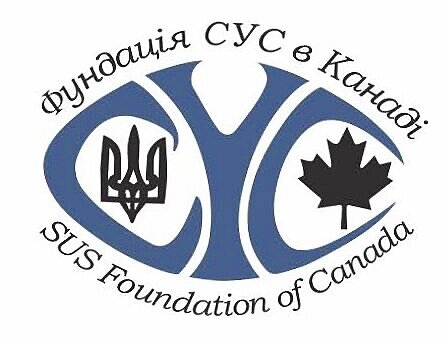 Financial support generously provided by:
Financial support generously provided by: 